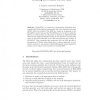Free Online Productivity Tools
i2Speak
i2Symbol
i2OCR
iTex2Img
iWeb2Print
iWeb2Shot
i2Type
iPdf2Split
iPdf2Merge
i2Bopomofo
i2Arabic
i2Style
i2Image
i2PDF
iLatex2Rtf
Sci2ools
PKC
2005
Springer
2005
Springer
Securing RSA-KEM via the AES
RSA-KEM is a popular key encapsulation mechanism that combines the RSA trapdoor permutation with a key derivation function (KDF). Often the details of the KDF are viewed as orthogonal to the RSA-KEM construction and the RSA-KEM proof of security models the KDF as a random oracle. In this paper we present an AES-based KDF that has been explicitly designed so that we can appeal to currently held views on the ideal behaviour of the AES when proving the security of RSA-KEM. Thus, assuming that encryption with the AES provides a permutation of 128-bit input blocks that is chosen uniformily at random for each key k, the security of RSA-KEM against chosen-ciphertext attacks can be related to the hardness of inverting RSA.
Cryptography | Key Derivation Function | PKC 2005 | Popular Key Encapsulation | RSA Trapdoor Permutation |
| Added | 28 Jun 2010 |
| Updated | 28 Jun 2010 |
| Type | Conference |
| Year | 2005 |
| Where | PKC |
| Authors | Jakob Jonsson, Matthew J. B. Robshaw |
Comments (0)

